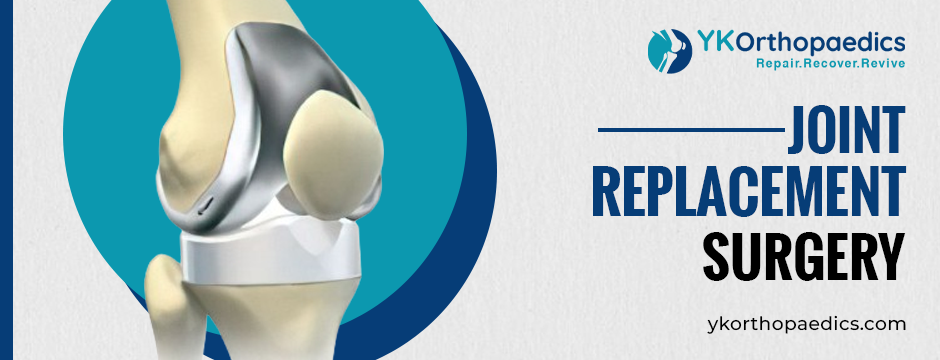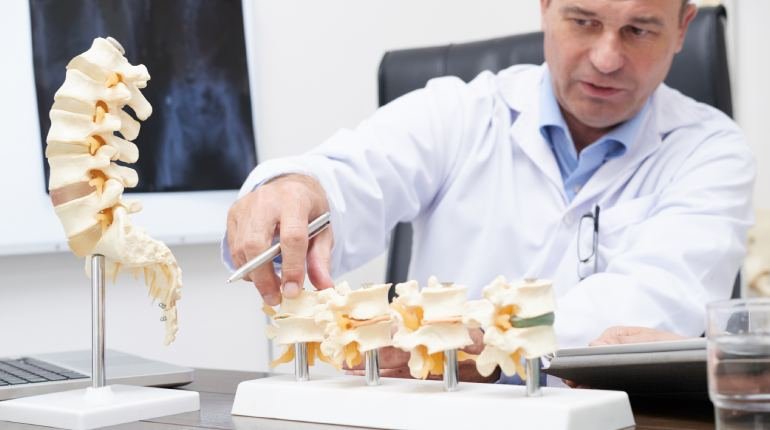
Basics of Joint Replacement Surgery: When Is It Necessary?
Joint pain can be debilitating, affecting a person’s mobility, independence, and overall quality of life. Whether due to ageing, arthritis, injury, or other factors, joint issues often impact the knees, hips, and shoulders the most. Joint replacement surgery, particularly knee replacement, has become a reliable option for individuals suffering from severe joint pain and dysfunction. But when exactly is joint replacement surgery necessary, and what should patients expect from the procedure?
In this blog, we’ll discuss the basics of joint replacement surgery, its necessity, types, and benefits, along with some insights into knee replacement surgery – the most common type of joint replacement. This guide will help you understand when it’s time to consider this option and what to expect during the recovery process.

Understanding Joint Replacement Surgery
Joint replacement surgery is a medical procedure where a damaged joint is replaced with a prosthetic implant. The prosthetic is typically made of metal, plastic, or ceramic materials designed to mimic the movement and structure of a natural joint. By replacing the damaged parts, the surgery aims to restore the function of the joint and relieve pain.
This procedure is often recommended for people who suffer from severe joint pain or stiffness, making it challenging to perform daily activities like walking, climbing stairs, or even sitting comfortably. The most commonly replaced joints include the knee, hip, and shoulder.
When Is Joint Replacement Surgery Necessary?
Not everyone experiencing joint pain needs surgery. Often, doctors suggest non-surgical treatments first, including physical therapy, medications, lifestyle changes, or other conservative approaches. However, joint replacement may become necessary when:
Non-Surgical Treatments Are No Longer Effective
If physical therapy, medications, and other treatments fail to alleviate pain or improve mobility, surgery may be the next step. For many patients, years of conservative treatment might bring some relief, but over time, the effects can diminish.
Severe Joint Pain Interferes with Daily Activities
Joint pain that disrupts basic tasks like walking, sitting, or sleeping can be a strong indicator for surgery. When individuals find it challenging to go about their day-to-day activities without significant discomfort, joint replacement may provide much-needed relief.
Chronic Inflammation or Swelling Persists
Chronic swelling and inflammation in the joints that do not respond to rest or medication may signal the need for surgery. This condition often indicates that the joint has experienced substantial wear and tear, which may only be resolved through replacement.
Joint Stiffness and Limited Range of Motion
People with joint stiffness may have difficulty bending or straightening the joint. When stiffness becomes a recurring issue and limits flexibility and range of motion, it can significantly impact quality of life. Surgery may be considered if the joint’s functionality cannot be restored through physical therapy.
Joint Deformity
Certain conditions like arthritis can cause joint deformities. Over time, misalignment or deformity in the joint structure can lead to further discomfort and limit movement, making joint replacement an essential option for regaining mobility and symmetry.
Types of Joint Replacement Surgeries
Joint replacement surgeries are classified based on the specific joint being replaced. Here are some of the most common types:
Knee Replacement Surgery
Knee replacement is the most common form of joint replacement surgery. The procedure is generally recommended for patients with severe osteoarthritis of the knee.In a knee replacement procedure, the surgeon removes the worn-out cartilage and bone from the knee joint and substitutes them with an artificial implant.
- Total Knee Replacement (TKR): Replaces the knee joint in its entirety.
- Partial Knee Replacement (PKR): Only a part of the knee joint is replaced, typically for less extensive damage.
Hip Replacement Surgery
In hip replacement surgery, the damaged portions of the hip joint are replaced with a prosthetic. This procedure is often performed on people suffering from arthritis or those who have sustained significant injuries to the hip joint. The new hip joint improves stability, reduces pain, and helps restore mobility.
Shoulder Replacement Surgery
While less common, shoulder replacement surgery is performed for patients with severe arthritis or fractures in the shoulder. In this procedure, the damaged parts of the shoulder joint are replaced with artificial implants to reduce pain and improve motion.
Other Joints
Replacement surgeries can also be performed on smaller joints, like those in the fingers, elbows, or ankles. These procedures are less common but can still bring significant pain relief and improved function to affected individuals.
Why Is Knee Replacement Surgery So Common?
Knee replacement surgery stands out as one of the most commonly performed joint replacement surgeries. The knee joint is a weight-bearing joint, making it prone to wear and tear. Arthritis, particularly osteoarthritis, is one of the primary causes of knee damage. This condition leads to the breakdown of cartilage, resulting in pain, swelling, and decreased mobility.
Knee replacement surgery is often seen as a solution for patients whose knees have become severely damaged by arthritis, injury, or other conditions. Many patients who undergo knee replacement surgery report reduced pain and increased mobility, allowing them to return to their daily activities without discomfort. However, it is essential to consider this option only after all other treatments have been explored.
Benefits of Joint Replacement Surgery
Joint replacement surgery offers a range of benefits, allowing patients to live more comfortably and engage in activities that might have been challenging before. Some of the key benefits include:
Pain Relief
A major advantage of joint replacement surgery is the relief from pain it provides. By removing the damaged joint and replacing it with a prosthetic, patients experience reduced joint pain, improving their overall comfort and quality of life.
Improved Mobility and Range of Motion
After recovery, patients often notice a marked improvement in joint flexibility, mobility, and range of motion. This enhancement enables them to carry out everyday activities with greater ease.
Enhanced Quality of Life
By alleviating pain and restoring joint function, joint replacement surgery can significantly improve a person’s quality of life, allowing them to remain active, maintain independence, and engage in social or recreational activities.
Reduced Reliance on Medication
Chronic joint pain often requires medications like painkillers or anti-inflammatory drugs. Post-surgery, many patients can reduce or eliminate their dependency on these medications, which is beneficial for long-term health.
The Recovery Process: What to Expect
Recovery from
can vary from person to person and depends on factors such as age, overall health, and the specific joint replaced. Here are some key points about the recovery process:
Post-Surgery Hospital Stay
Patients typically stay in the hospital for a few days after the surgery. During this time, they receive pain management, and physical therapy sessions begin to promote movement in the new joint.
Physical Therapy and Rehabilitation
Physical therapy is a crucial aspect of recovery. Exercises are designed to strengthen muscles around the new joint and help regain movement. Consistency in following the therapy plan significantly impacts the speed and quality of recovery.
Pain Management
Pain is managed through medications initially, but as the healing progresses, the pain diminishes, and patients often no longer require strong pain relievers.
Gradual Return to Activities
Patients are encouraged to gradually increase their activities and avoid heavy lifting or high-impact exercises initially. It may take a few weeks to months to resume daily tasks comfortably, and the full benefits of the surgery may be felt after a year.
Follow-Up Visits
Regular follow-up visits with the surgeon help monitor the healing process and check the implant’s stability.
Risks and Considerations
Although joint replacement surgeries are highly successful, there are risks associated, including infection, blood clots, and implant wear over time. Some patients may experience stiffness or instability if the rehabilitation process is not adequately followed. It’s important to have a detailed discussion with the surgeon to understand these risks and make an informed decision.
Conclusion
Joint replacement surgery, particularly knee replacement, is a life-changing procedure for those struggling with severe joint pain. When non-surgical treatments no longer provide relief, and pain begins to interfere with daily life, joint replacement may be a suitable option. By understanding the types of surgeries available, their benefits, and the recovery process, patients can make more informed decisions about their health and well-being.
If you or a loved one is considering joint replacement surgery, consult an experienced orthopaedic specialist to determine if the procedure is right for you. With the right guidance and post-surgery care, joint replacement can help you regain your mobility, independence, and quality of life.
You can consult Dr. Yugal Karkhur for joint replacement surgery in Gurgaon or arrange an online consultation.




